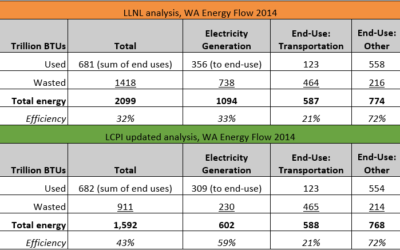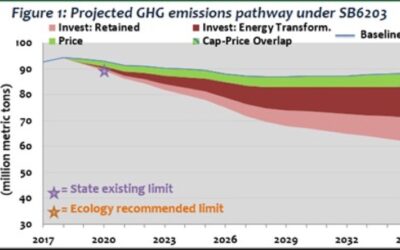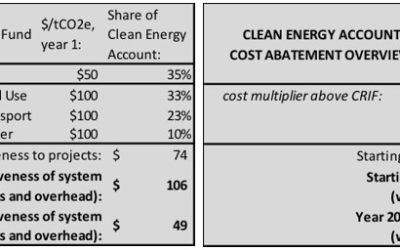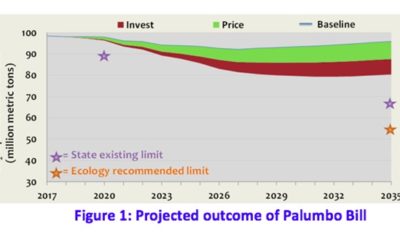All Stories
Wasted energy: Increasing efficiency can reverse a major drag on Washington’s prosperity
Clean & Prosperous Institute (CaPI) analysis indicates that Washingtonians spent over $24 billion on energy in 2015 – down from nearly $28 billion in 2014 – with nearly 60% ($13 billion) spent on wasted energy. Efficiency gains are an opportunity to generate immediate economic benefit and foster a clean technology boom.
Wasted energy: Ten opportunities to reduce a $13 billion annual bill
Clean technology can boost energy efficiency, reduce waste, and save Washington State billions of dollars annually, while developing a competitive advantage in a multi-trillion dollar industry. Here’s a sample of some significant strategies to make this happen.
Appendix: Wasted Energy additional details
Section 1: Updating the Sankey diagram
Sankey Diagrams, like those produced by LLNL, are an information-rich visual depiction of energy or other (e.g. carbon, money) flows from inputs to final use.
Section 2: Carbon content of wasted energy
CaPI analysis estimates around 50 million metric tons of carbon dioxide (MtCO2) associated with wasted energy in 2015.
California Reaches Climate Change Mitigation Goal Ahead of Schedule
Former Republican California Gov. Arnold Schwarzenegger, who signed California’s landmark AB 32 climate legislation in 2006, celebrated beating the target with remarks published in the San Francisco Chronicle: “Surpassing our 2020 emissions goal ahead of schedule while our economy grows by a nation-leading 4.9 percent and our unemployment rate is at a historic low should send a message to politicians all over the country: you don’t have to reinvent the wheel—just copy us. Business will boom and lives will be saved.”
Revenue & Emissions Preliminary Impact Analysis – Senate Bill 6203
Using a proprietary modeling system, the Washington Business Alliance analyzed the expected outcomes of Senator Palumbo’s Carbon Tax Bill, Senate Bill 5930. SB 5930 is projected to generate a peak of roughly $1.8 billion/year in 2024 (in USD, 2018), and reduce greenhouse gas emissions by a similar amount as the Clean Air Rule (CAR): around 180 million metric tons of carbon dioxide equivalents (MtCO2e) give or take around twenty percent. Emissions in 2035 are projected to be around 9% lower than 1990 levels.
House Bill 1646: Revenue and Emissions Impact – Preliminary Analysis
The Washington Business Alliance developed the Washington State GHG Reduction Explorer to project the outcomes of various policy proposals that tax/regulate greenhouse gas emissions. We evaluate two scenarios for this analysis: one with what we believe are relatively optimistic assumptions about Clean Energy Account investments and one with what we believe are relatively pessimistic assumptions about the Clean Energy Account investment cost-effectiveness.
Modeling Analysis of SB 5930 (Sen. Palumbo) Carbon Tax Proposal – Additional Details
Using a proprietary modeling system, the Washington Business Alliance analyzed the expected outcomes of Senator Palumbo’s Carbon Tax Bill, Senate Bill 5930. SB 5930 is projected to generate a peak of roughly $1.8 billion/year in 2024 (in USD, 2018), and reduce greenhouse gas emissions by a similar amount as the Clean Air Rule (CAR): around 180 million metric tons of carbon dioxide equivalents (MtCO2e) give or take around twenty percent.
Modeling Analysis of SB 5930 (Sen. Palumbo) Carbon Tax Proposal
Using a proprietary modeling system, the Washington Business Alliance analyzed the expected outcomes of Senator Palumbo’s Carbon Tax Bill, Senate Bill 5930. SB 5930 is projected to generate a peak of roughly $1.8 billion/year in 2024 (in USD, 2018), and reduce greenhouse gas emissions by a similar amount as the Clean Air Rule (CAR): around 180 million metric tons of carbon dioxide equivalents (MtCO2e) give or take around twenty percent.
Carbon Policy Explorer Enables Better Decision-Making
At the Business Alliance we began to wonder how effective these different policies are likely to be at actually reducing GHG emissions and at what price. So we developed analytical software tools to evaluate the many scenarios being proposed. In evaluating all these proposals, voters and lawmakers alike are facing a lack of basic information about the different proposals. It’s difficult to identify comparative fiscal impacts, likely changes in energy costs, and the projected effectiveness of each policy in lowering greenhouse gas (GHG) emissions. That is why the Washington Business Alliance developed the GHG Reduction Explorer, intending to project the outcomes of various policy proposals that aim to price and regulate greenhouse gas emissions.








